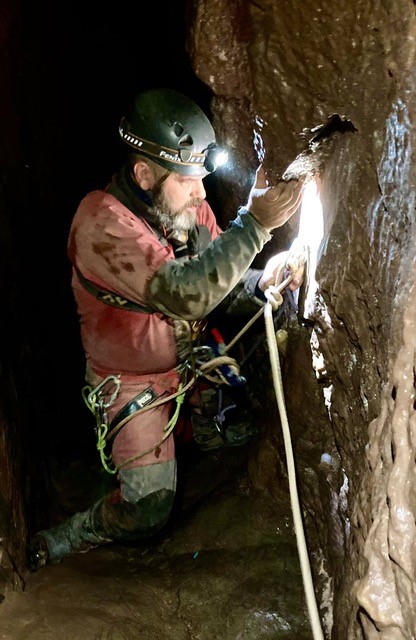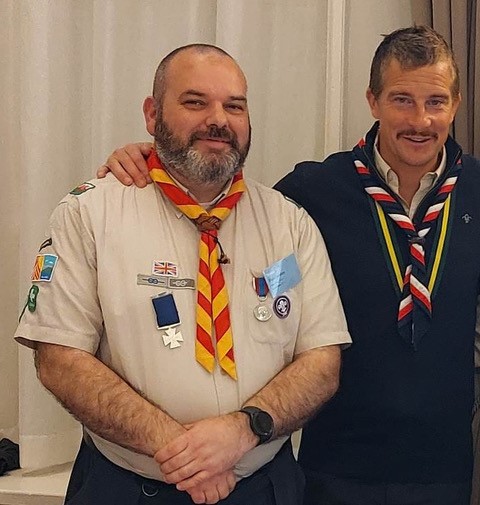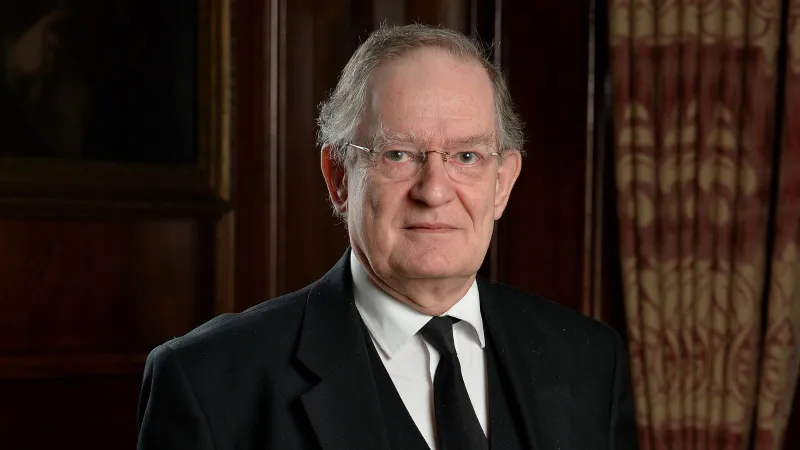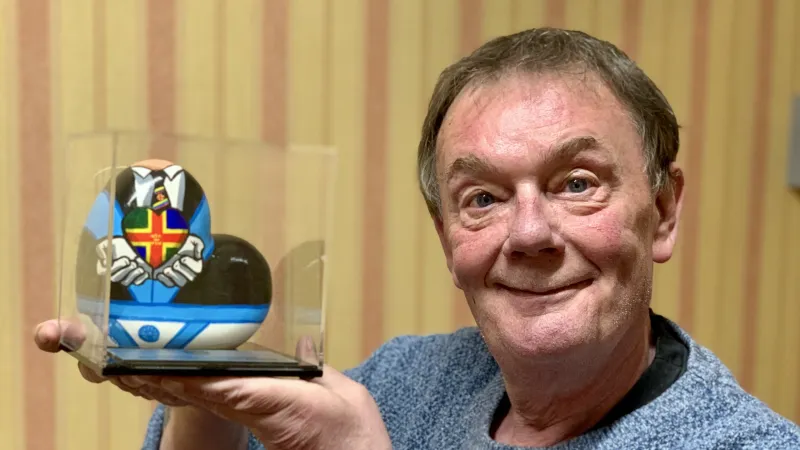In November 2021, 300 Cave Rescue volunteers from all over the UK came together in the Brecon Beacons to assist a caver who had sustained severe, potentially life-threatening injuries in a fall in the Ogof Ffynnon Ddu cave system. The team worked together for a staggering 54 hours to safely extract the injured man from the cave and hand him into the care of the NHS. Piers Hallihan, a Past Master of both the Themis Lodge and Tennant Lodge in the Province of South Wales, tells some of the story of his involvement in the rescue and explores some of the life events and experiences that formed the connections that put him at the heart of this incredible success story.
“…and part to serve a friend or brother in time of need.”
Every Freemason will have heard those words on many occasions. Each ascribes their own personal meaning to the phrase, and for some, it becomes a part of their life, shaping many other commitments.
Tony Harvey’s 2012 Prestonian Lecture – Scouting and Freemasonry: Two Parallel Organisations – discusses the connection between the two and their similar aims. Anyone with any knowledge of either organisation will be aware that both deem the rendering of service to others to be amongst the highest of their aims.
Indeed, the Scout Promise, made by all members of the movement in the UK, sees a member make a promise “to help other people.” Piers first made such a promise on joining the Scouts in the 1980s, reinforcing it by becoming an adult Leader in the mid-nineties. In 2004, he was Initiated into the Themis Lodge, where he first learned about a Freemason’s obligation to help others.
In 2010, Piers changed career to become a Police Officer, taking yet another oath with a very similar commitment.
One of the activities that Piers was first introduced to as a teenage Scout was caving. This has become a passion, not just for Piers but for his whole family. There are many caving clubs meeting in the limestone mountains of South Wales, forming strong social communities as well as sharing a love of caving and other outdoor activities. As he developed skills as a Caver and a Scout Leader, Piers looked to combine the two and, in 2013, worked with local Scouting managers to form what is now the Cardiff and Vale Scouts Active Support Unit (SASU) for Underground Activities. This SASU runs caving experiences for young people in the South Wales area and works to develop leadership skills so that future generations will also have the opportunity to undertake the same experiences. Working with young people in such a challenging environment requires something more than a basic First Aid qualification, and, to Piers, it seemed a natural progression to turn that enhanced training into a more practical skill. Already an active member of the South & Mid Wales Cave Rescue Team, in 2015, Piers qualified as an Advanced First Aider / Casualty Carer after being assessed in a challenging First Aid course jointly administered by Mountain Rescue England and Wales (MREW) and the British Cave Rescue Council. He later added to this a First Aid Training competence and now teaches First Aid to Police Recruits as well as Scouts of all ages, from 6 years old to over 80.
Discussing the connection between these various activities, Piers asks us to imagine a Venn Diagram made up of five circles. The first four circles signify his roles as a Police Officer, Scout Leader, Freemason and Caver and are all loosely connected. They are solidly bound together, however, by the fifth central circle, which signifies the bonds of companionship, self-development, and service to others.
On the afternoon of 6th November 2021, South Wales Caving Club was preparing to host its annual bonfire and fireworks party – this is usually a very well-attended event with 80-100 members and their guests present, so it requires a good deal of planning. Piers’ wife, Annie, and their then 17-year-old son, James, were at the Club – James was on a caving trip with a group of his peers (the Club has an active Youth section, and many of the children are highly competent cavers). Annie was working with friends in the kitchen to prepare for the evening’s party.
Piers was in Bridgend with their younger child, Bailey, helping his elderly parents settle into their new sheltered accommodation when his phone rang – with Annie’s number displayed on the screen. On answering, there was no preamble, just the words, “Whatever you’re doing, go home and pack your kit. There’s a shout on, and it’s going to be big. Serious injury in Cwm Dwr.”
Cwm Dwr Quarry Cave, to give it its full name, is one of the caves that make up the Ogof Ffynnon Ddu system in the upper Swansea Valley. It has some enormous chambers decorated with stunning calcite formations. These are accessed via a series of much smaller passages, some of them measuring less than a foot in height, meaning that the rescue of an injured caver becomes a serious logistical challenge. In this case, the casualty had fallen approximately eight metres, sustaining significant injuries, and there was no way that he could be forced, on a stretcher, through the intricately winding entrance passages. There would be no option but to carry him deeper into the cave, to its connection with the main Ogof Ffynnon Ddu system and then out to the surface via one of the larger entrances.

Many UK Cave Rescue teams utilise the same callout system as their Mountain Rescue colleagues. An internet-based system called SARCALL (Search And Rescue CALLout). Team members have an app installed on their phones, which operates as a pager, alerting them to any incident. Piers’ pager went off within seconds of ending the phone call to his wife, and he headed home to collect the caving kit and other equipment essential to working on a prolonged rescue. Knowing that a rescue from that location could easily last twenty-four hours or more, he also had to arrange for someone to support 14-year-old Bailey. His brother was the obvious candidate. Being a Firefighter, he understood the nature of the call and the need to respond.
Walking into the hastily set up control room in the Caving Club a little over an hour after receiving the initial call, Piers was briefed on what was known so far and assigned his first task of the weekend. Cave Rescue relies on a vast number of skills for success, meaning that many team members train in different areas. There was already an initial response team, including two very experienced First Aiders, with the casualty meaning that Piers’ First Aid skills were not immediately needed. What was needed was a secure channel to communicate with the underground team and more advanced medical care. Being trained in the use of the specialist underground communication equipment (essentially a very low-frequency radio device, capable of transmitting text messages through up to a kilometre of solid rock) as well as being familiar with the route through the entrance series, Piers was to be part of a team escorting a Doctor to the scene of the fall and to carry the communication equipment needed to relay information from the Doctor back to the Control Room – setting up an underground communication base and manning it for the rest of the evening. After spending around seven hours underground, Piers and his team emerged from the cave at around midnight to be handed a plate of hot food by James. Insurance rules for Rescue teams prevent the deployment of under 18’s on live rescues, so despite having over 30 years of caving experience between them, James and his two friends were unable to help directly with the incident and had made use of another set of skills acquired through Scouting to join Annie and become part of the massive, round the clock, catering operation needed to support the endless stream of volunteers heading underground.
After a reasonable period of rest, Piers switched to his role as a Casualty Carer. A small team was needed to escort another Doctor to the casualty who, overnight, had been extracted from the very tight rift where he had fallen and was now relatively stable in a stretcher, ready to begin the long journey to the surface. Piers then stayed with the doctor for the rest of the day, working, in effect, as a nurse to support the Doctor as they cared for the casualty – administering medication as required and working with the underground teams to keep the casualty as comfortable as possible as they moved through the cave.
A cave is a difficult environment in which to operate. Often, space is limited, meaning that the stretcher can only be moved a few centimetres at a time before the team has to reset and re-position themselves for the next move. It is also three-dimensional, meaning that the move could be in any direction, up, down, or sideways. All these factors mean that progress is slow. It’s an accepted rule in Cave Rescue that a stretcher will move at around ten percent of the speed of a fit caver – a journey that might take a fit caver an hour to complete will take ten hours to move a stretcher through. The trip the stretcher was to undertake on this weekend is reckoned to take between four and six hours for a party of active cavers, so the team knew they were in for a long haul.
To add to all those challenges, a large part of the casualty’s journey followed an active underground river. Over the 12 hours he spent with the casualty that day, Piers observed first hand some incredible acts of selflessness, including teams of rescuers kneeling in the dark river so that the stretcher could be slid over their backs, ensuring that the casualty remained warm and dry. The biggest risk to the casualty at this point was not his injuries, which had been stabilised and managed by the medical team, but hypothermia. With no way to move around and generate their own body heat, a wet casualty’s condition would decline very rapidly and, potentially, fatally.
The daytime medical team handed over to a new team made up of volunteers from Somerset, Essex, and Derbyshire very late on Sunday evening before backtracking along the route followed by the stretcher to emerge from the cave in the early hours of Monday morning.
Having not been able to contact his supervisor over the weekend, Piers was expected to work that day, so he made his way home to get a few hours of sleep. In all the excitement and focus on the casualty, he had managed to forget the date – something he was reminded of when passing through the front door a little before 3 a.m. to the strains of “Happy Birthday” from his family.
After completing a day in the office and arranging with supervisors to take the following day off to support the rescue effort further, Piers returned to the cave at around 6 p.m. to join the team of approximately seventy rescuers for the last few hours. The team worked together, hauling, sliding and carrying the stretcher through the final metres of the cave before loading the casualty, supported by the doctor, onto the waiting team Landrover Ambulance for the short journey down the hill where he was handed over to a waiting NHS ambulance for conveyance to the University Hospital of Wales in Cardiff.
The team, some of whom had travelled from as far as Yorkshire or Devon, dispersed to make their weary journeys home. Some remained – there was still work to be done.
Massive amounts of equipment lay along the route taken by the stretcher. Most of it would be fine, safe where it was until a more relaxed clear-up could begin, but a small amount, ten bags or so, was either in or near the underground streamway. A river that is an enjoyable wade for most of the year but becomes an unstoppable torrent, more than four metres deep in bad weather. A storm was forecast for the following afternoon/evening, meaning that there was a narrow weather window in which the team could retrieve that valuable, lifesaving equipment.
So, at 10 a.m. on Tuesday, Piers went back into the cave with a small team in yet another new role. Three of the team would head deep into the cave to retrieve any equipment from the stream whilst Piers and another caver went to a point in the cave directly above the stream to set up a system of ropes to haul this heavy equipment about thirty metres up to a ledge where it could be safely left, well away from any flood risks, until a larger team could carry it all out later in the week.
It was later that evening that the connections began to evidence themselves.
That evening, Piers was back in his other voluntary role as a Scout Leader in Cowbridge when he received a message from the chair of the National Scouts Caving SASU. It transpired that the various news reports shown around the country had been seen by staff and volunteers at UK Scout HQ at Gilwell Park, North London. Knowing that there was at least one Scout Caving team active in the region, they were keen to know whether any members of the National Scout Caving Team had been involved. Over the next few days, a list of members was collated, and it turned out that there were fifteen volunteers from across the UK who were directly involved with Scout Caving. This included James and his two friends, who were Explorer Scouts at the time, as well as Piers and the Advanced First Aider from Essex, whom he had met for the first time when they handed over the casualty late on the Sunday evening, deep underground.
Several weeks later, a notification came through that each of the fifteen were to be recognised for their efforts by Scouting’s Awards Panel. The awards ranged from Chief Scout’s Personal Commendations for the three youngsters who had hidden their frustrations at not being able to deploy underground and instead worked around the clock to feed those who were deployed to Silver Crosses for Gallantry for Piers and the Essex Medic.
This represents a massive honour – these are very rare awards, described by the Scout Association as being “awarded for acts of bravery in the face of danger where life has been at considerable risk.” Only nine have been awarded in the decade prior to this, and none of those have been in Wales.
There is only one higher Gallantry Award in Scouting – The Bronze Cross (Scouting follows military tradition where the highest military award, the Victoria Cross, is cast from the bronze taken from guns captured during the Crimean War). That was last awarded in 2019 to another member of the South and Mid Wales Cave Rescue Team and Somerset Scout Cave Leader, John Volanthen, for his leading role in the spectacular rescue of the 13 Thai Footballers from a flooded cave in Northern Thailand.
Speaking about his award, Piers said, “Whilst this award is a great honour, the fact of which I am most proud is that three of the Scouts that I nurtured through their early years of caving also received recognition. Two of them are now eighteen and have been invested as Scout Leaders as well as qualifying as Scout Cave Leaders and joining the Cave Rescue Team as full, active members. In addition to that, in a validation of Tony Harvey’s suggestion that those who are attracted to Scouting may find a similar, parallel attraction to Freemasonry, my son, James, has been proposed as an initiate and will be joining me in Tennant Lodge early in the new year.”
In April 2023, many of the fifteen Scout Cavers were reunited when they met at Windsor Castle for the annual St George’s Day Scout Awards event. This was followed by a lunch at the Castle Hotel, where the award holders were introduced to Chief Scout Bear Grylls.

We are very pleased to report that the casualty has made a full recovery and returned to caving. Also, James was, indeed, initiated into the Tennant Lodge in January of this year.
South and Mid Wales Cave Rescue Team and the local Scouts are just two of many charities supported by the brethren and visitors of Tennant Lodge.
If you’d like to know more about Cave Rescue, visit the British Cave Rescue Council (caverescue.org.uk) website (Where you’ll also see a rather dashing photo of Piers taken on a joint training exercise with Midlands Cave Rescue Organisation in a mine in Shropshire)
For more information on the connections between Scouting and Freemasonry, visit the Kindred Lodges Association (kla.org.uk).


